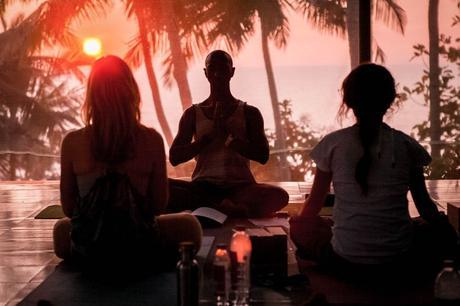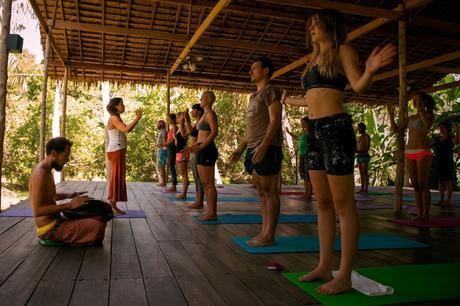
A holistic yoga and meditation retreat in Gio, India. Courtesy of BookRetreats.com
Each year, we see trends in health, fitness and fashion splashed across magazines and runways. But those aren’t the only industries with trends. The travel industry is constantly emerging with new trends, whether it’s where people are flocking to for vacations or how they’re traveling and vacationing.
And 2016 is no different. This year, there are several travel trends that are expected to continue and even pick up steam, with travel experts predicting they will steadily grow for years to come.
We asked close to 40 world travelers and travel experts what they expect to see happening in the travel industry in 2016. Here are the themes that rose to the top:
Embarking on adventure travel
While there are still millions of people interested in spending their vacations lounging on an exotic beach, more and more people are looking to do a little bit more with their time away from work and home.
“Adventure travel has been a growing trend for a while now, and as this keeps growing,” says Wendy Knecht, a world traveler, former Pan Am flight attendant, and author of Life, Love and a Hijacking: My Pan Am Memoir. “The rise of fitness awareness has created a demand for ‘sport holidays’ along with adventure travel. If you can’t afford the pricy adventure travel groups, you can take a look at their itineraries and recreate them on your own. It’s great to come home and not feel like you’ve put on some extra baggage too.”
Traveling with a purpose
“More and more travelers are looking for a way to give back and use vacation time for volunteer opportunities that help local communities worldwide. Organizations such as Globe Aware put together trips to places such as Cambodia or Guatemala or Peru, where volunteers can see tangible results from their efforts” says Knecht.
Vacationing for health and wellness
Similar to adventure travel and voluntourism, people are using travel and vacation as an excuse to work on themselves with spa

A yoga retreat with Reiki in Andalucia, Spain. Courtesy of BookRetreats.com
vacations.
Sean Kelly, the co-founder of BookRetreats.com, says the trend of wellness retreats has been on the rise for years now and continues to do so.
“We’re seeing more and more people who want to go on yoga retreats, detox retreats, and general wellness retreats,” he says. “People are realizing that the old ‘lay on the beach vacations’ don’t nourish them as much as a wellness retreat does.”
One possible reason this trend will continue this year: urbanization. More than 50 percent of people around the globe live in some type of urban area, which is up from 29 percent in 1950.
“Why does that matter? Because you have an entire generation of stressed-out, worked-to-the-bone, disconnected from nature people who crave the sort of nourishment a wellness retreat can provide,” Kelly says.
According to the Global Wellness Tourism Economy report, wellness tourism is expected to grow about 10 percent each year until 2017 when it will become a $678 billion market. In fact, a recent survey performed by the Global Wellness Summit reports that wellness travel is growing 50 percent faster than regular travel.
“As people continue to seek out meaningful experiences, wellness tourism will continue to rise,” says Tracy Memoli, a New York-based food and travel blogger for the blog Suite & Savory.” Now more than ever people are finally starting to put their health and wellbeing first, which is a fantastic thing! And the great thing about incorporating a health and wellness retreat into your travel plans, there are so many options now to choose from all around the world.”
Wondering what to expect on a wellness retreat?
“You can expect to unplug, de-stress and re-charge,” Kelly says. “They are usually located in a beautiful surrounding area, with various activities being offered. It’s different that a lay-on-the beach vacation, which doesn’t fully nourish you. Instead you’ll likely be involved in things like meditation, yoga, hiking, surfing and more.”
And, if you embark on a seven-day retreat, you can expect seven days of healthy and delicious food.
“It’s an incredible way to push the reset button on your eating lifestyle and install new, more beneficial habits,” Kelly says.
Essentially, wellness retreats are very different than your typical vacation, where you may find it difficult to completely disconnect from work and technology, leading to stress.
“With the help of attentive staff that care about your health, wellness retreats allow you to really focus on yourself, relax and unplug 100 percent,” Memoli says. “After your stay, you’re feeling the greatest you’ve ever felt. And that feeling is somewhat addictive – that’s why I think we’re going to see a rise in the number of people incorporating wellness travel into their travel plans this year.”

A tantric massage and yoga retreat in the rice fields of Ubud, Bali. Courtesy of BookRetreats.com
Sharing and living like a local
It was announced at the Financial Times Sharing Economy European Summit that the value of the sharing economy has grown to $15 billion in the past seven years.
“We’re seeing the sharing economy become more main stream—the notion of exchanging as a special privilege for the lucky few is becoming more and more antiquated,” says Ed Kushins, the founder of HomeExchange.com, which allows its club members around the world to swap homes or apartments for vacations.
Kushins credits the rise in this trend to travelers’ increasing interest in International travel – his organization is well-established in North America and Europe, and is now taking root in China, Japan, Brazil, Chile, South America, Australia and New Zealand.
“Besides the rise in international interest, the sharing economy is both economical and sustainable. Hotel prices are slated to rise in 2016, and travelers can look towards home swapping and the sharing economy to provide budget-friendly options,” he says.
But it’s not just being fueled by financial reasons.
“Travelers are looking beyond hotels and rentals for more memorable, meaningful and authentic experiences. When you swap homes, you do so as an invited guest, not a paying customer—and have the opportunity to live like a local,” Kushins says.
Finally getting to Cuba
“Cuba, the formerly off-limits land of vintage cars, beautiful beaches, cigars, mojitos, and Ernest Hemingway has re-opened to

Tracy Memoli hiking during a week-long wellness retreat. Courtesy of Tracy Memoli
American tourists after 50 years. This spring presents a perfect opportunity to visit it before it has modernized too much or lost any of the charm of its cultural isolation from the U.S.,” says Daniel Farrar, CEO of Switchfly, a global technology company that powers travel commerce and loyalty point redemption solutions. This organization recently surveyed Americans’ interest in travel to Cuba, now that diplomatic tensions are relaxing. Ultimately, the survey found that the general American population’s interest in traveling to Cuba is tepid, except for one group – millennials.
“That is definitely where the majority of initial interest lies. And my guess is that, as the first wave of travelers come back enchanted, it won’t take long for other Americans’ interest to be piqued,” Farrar says.
Farrar isn’t alone in this prediction – Travel Leaders Group is also predicting travel to Cuba to be a top luxury travel trend this year.
“Because Cuba will undoubtedly change rapidly in the coming years due to the influx of American tourists and business influences, a growing number of [our] affluent clientele want to experience its captivating time-stands-still charm now,” says Patrick Fragale, president of Protravel International, which is a brand of Travel Leaders Group.
“The proximity, the people and the culture are all part of the appeal. When Americans can freely travel to Cuba for any type of vacation – not just a cultural exchange – and more luxury accommodations become available, I see Cuba moving from our up-and-coming list to join our overall list of top international destinations for luxury travelers,” he says.
American travelers’ intrigue in Cuba is fueled by the U.S.’s rules, embargo and enmity to the Caribbean island for 50 years, which is now loosened and easing. But it’s also fueled by the possibility of change expected to come to this destination.
“Travelers wanting to experience Cuba’s rich Afro-European culture as it has been for generations are encouraged to travel now,” says Peggy Goldman, travel expert and founder and president of Friendly Planet Travel. “Change is definitely coming to the island, but, for now, visitors can participate in the deeply immersive People-to-People exchanges that give Americans the chance to interact with Cubans, to share their vibrant art, music, food and more in intimate settings.”
For those interested in traveling to Cuba for the first time, Farrar recommends bringing plenty of cash to exchange upon arrival at the airport – Cuban banks aren’t yet accepting American bank cards. He also advises to have your visa in order before you leave too.
“Those two precautions will prevent some serious headaches,” Farrar says.
Not sure what you should do or see once you get to Cuba? Here are Farrar’s recommendations:
- The Malecón, which was built in the 1990s, is the quintessential Cuban ocean-front boulevard
- Valle de Viñales is a stunning natural park right outside of Havana
- Castillo de San Pedro de la Roca del Morro is a 16th century military fort with ocean views in Santiago de Cuba
- Cuba has many beautiful beaches to see – some of the best are Varadero, Playa Paraiso at Cayo Largo, and Playa Pilar at Cayo Guillermo
- Trinidad is a beautiful old town in Sancti Spíritus, central Cuba – it’s been a UNESCO World Heritage site since 1988

Tracy Memoli during a week-long wellness retreat. Courtesy of Tracy Memoli
Seeing Colombia after a tremendous turnaround
Colombia was recently voted a top five emerging destination for 2016 by members of the United States Tour Operators Association. Why does this matter? For many years, travel to Colombia was a bit taboo due to a reputation for crime and poverty – this is no longer the case.
“Colombia is an up-and-coming destination this year – it’s shedding its dangerous reputation of the past and, with an increase in security, many travelers are being drawn to its rich history and culture, colonial cities, mountains, coffee regions and beautiful beaches,” says Samantha Hartman, a travel consultant for ProTravel International.
Colombia has experienced a major turnaround from a turbulent past to a destination that is now getting on American tourists’ radars.
“While its major cities are vibrant, visits to smaller towns around the country offer a unique insight into the culture of the country’s warm people. The ‘it’ destination in Colombia is Cartagena. A Caribbean port [for the] gold and jewel trade during the Spanish Colonial Era, the old city is walled-in and filled with picturesque architecture. The city’s history, architecture and nearby Caribbean beaches are what draws many travelers,” Hartman says.


